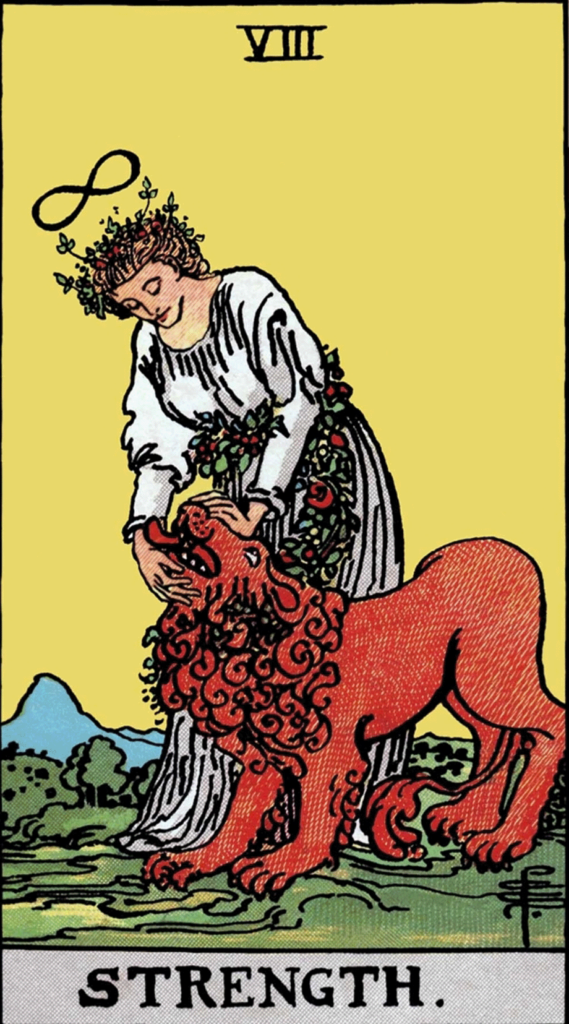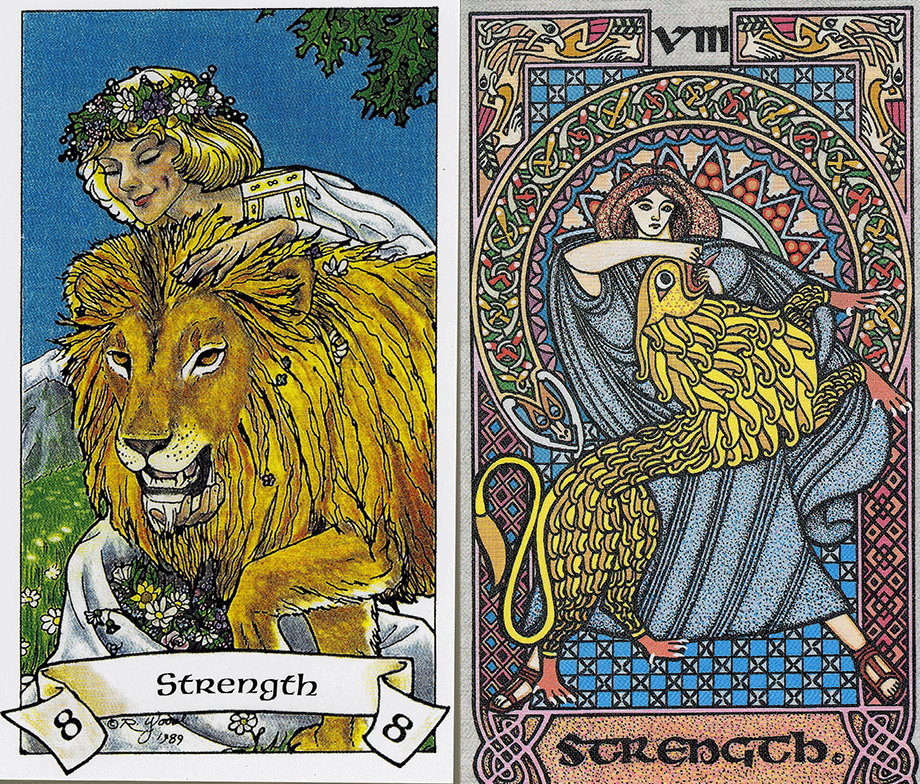The card that is labeled VIII is different depending on the deck you are using. The Marseilles Tarot has Justice in this position, and some modern decks use this scheme. In the RWS and it’s predecessor the Tarot of the Order of the Golden Dawn, the card is switched to Strength and many, if not most, decks from the last century deploy them according to this order. The most satisfactory explanation I have found is that the Golden Dawn applied the numeric value of the Hebrew letters to the Zodiac and got the number eight for Leo, and eleven for Libra. Thus, the image of Justice, with the scales, being associated with Libra, moved to XI, and the Strength card, with it’s lion, was relocated to VIII. This seems less arbitrary than other explanations, but it has flaws. As the whole idea of connecting the Hebrew letters to Tarot comes from Eliphas Levi, one would expect the switch to have been made by him if there were merit to the astrological argument. But Levi holds to the placement of Justice after the Chariot card. This merely illustrates that the Tarot is not an ancient secret code carved in the stones of a lost pyramid somewhere, but a living exercise in the exploration of the esoteric, and it’s connection with the changing fashion of the human mind. This can be adduced by the large numbers of oracle cards now available on the market, which dispense with traditional tarot almost entirely, but use the same general concepts.
The Strength card shows a woman bending to shut the mouth of a lion. She has a garland of roses for her belt and a crown of vines or flowers atop her tied hair. Her gown is white. Above her head is the infinity symbol, seen first on the Magician. There is a single mountain in the background, and a verdant landscape between. The sky in this card is yellow. The sash of the woman seems to circle around the lion’s neck.

The motif of the woman and lion is sometimes depicted as Hercules slaying the Nemean lion. This Visconti-Sforza deck in the Morgan Library collection has this version, and it may be original. The Marseilles has a female figure, and likely reflects this depiction of the virtue of Fortitude or Strength as a woman, in line with Medieval thinking. The Sforza’s may have wanted to allude to the more classical myth as testament to their secular humanist world view, but Hercules doesn’t typically feature on many modern decks.
My first personal response to this card is always that it symbolizes my wife’s birthday. She is born on the cusp of Leo and Virgo and I can think of no more apt metaphor than the woman in white closing the mouth of the beast. I do not typically assign the “traditional” astrological values to the cards, because I often find good reason to disagree with them, but let’s assume that the usual attribution of Virgo to card IX – The Hermit is used, and the Leo referenced above applied to this, then we are in something of a logical zodiac order here. The Chariot, by the way, get’s assigned to Cancer the preceding sign. The problem with that (and why I don’t use a lot of the traditional values) is that Cancer also gets assigned to the Priestess, and then the Magician being connected with Mercury comes over as Gemini and not Aries. Keeping track of this astrological soap opera seems to me to be worth less than the effort. That said, if I feel that there is a need for an astrological reading, I will go look it up (if I don’t know it) and weight it in context with the other values of the other cards in context.

Even so, I always see this card personally as a day in late August, and assign it the value of transition, the passing of time, and the shifting of seasons from one of growth to one of harvest. The moebius over her head signifies that this shift is a perpetual one, the cycle repeats, and so it gives us a symbol of the cycle as well. While this is but the slice of summer’s ending, it remembers the bloom of spring, and foresees the golden leaves of autumn and the barren fields of winter, waiting to blossom again.
In this way, the card speaks to me of Mother Nature. She has in herself the capacity to shut up the privation and reckless excess that may be heralded by the lion. For all the lion’s strength as an emblem, it is a predator. It destroys. Like the heat of the Sun that rules Leo, if unslaked, it will burn and blast. So we may read this card in context of the environmental struggles we are having with the planet now. Like Leo we proudly assert our dominion. Our vanity threatens to ruin us, however, and the planet will put us in check.
But lets look again at this card. The woman shutting the lion’s mouth is doing so without undue force or violence. The lion, after all, is just being a lion. It is following its nature, whether than nature is to the benefit of its environment or not. The lion is what it is. To deny that would be cruel to the lion.

There’s an internet joke that this card depicts trying to get a cat to swallow a pill. Having several small “lions” ion my household, I can attest that is not far from reality. But let’s consider that. We want our pets, our friends, to be healthy, so we want them to take their medication. They do not want to because it’s not natural for them to do so. Cat’s don’t take pills. Cats, in fact, are canny enough to act like they swallowed the pill, hide it in their mouth, and wait until you are not watching to spit it out. I have seen them do this.
So how do we make the cat take the pill? As gently, but as forcefully as we can. Because we want them to get better. This is what the figure of Strength is doing here. She is gently pushing the lion’s mouth shut. She has even wrapped her sash around him to make him feel like family. Because he his family. He is part of that nature that she represents. Yet she has to get him under control.
He has to swallow the pill.

Speaking of deviance, the Deviant Moon Tarot (which I’ve had for about a decade now) seems to be a favorite of witches, at least the one’s I know. It is very dark, situated in an odd twilit world that evokes to me Carnival in Venice, and the intrigues of the Renaissance courts. In this interpretation the “lion” has become a kind of wyvern, serpent, or possibly an eel. The contest between the figure of strength – something like a circus strongman, and the creature connects back to the images of Hercules and the Nemean lion on some Renaissance decks. Curiously, the Deviant Moon is one of those decks that number this as XI, and have it between the Wheel of Fortune and the Hanged Man
There’s a message here. While we tend to see the two figures as separate and distinct, they are inexorably connected. The natural behavior of the lion is “what nature intended” yet nature, in the guise of the woman, is overriding that. This card is about the mastery of our own passions, the domination of the fiery side of our nature, which is quick to anger, quick to hurt, and hard to tame.
Yet in taming it, we become more able to function, with our family, friends, co-workers, and society in general.
We also need to swallow the pill.
This is not to say that we can deny that nature. If we do that, it is cruel and harmful to us as well. In that fire is our passion and drive as much as our anger and hate. But we need to know that the anger and hate are always there, and always ready to pounce. All it takes is for our strength to fail.
The lions hunt the weak because they are the easiest to bring down. They will avoid a strong opponent, because they know they can be defeated. This is their nature. It is up to the individual to retain that resolve, so that the more negative aspects of the inner fire do not overwhelm and devour us.
There’s an interesting link to the context that this card is sometimes exchanged with Justice in several decks. Justice is about enforcing the balance, to insure that order is maintained for the good of all. Strength is about maintaining an inner balance, so that we do not do harm to ourselves or others.
I’d mention also that this the first card since the Fool that doesn’t seem to be interested in us. That is, if we look at the images of the Magician, Priestess, Empress, Emperor, Hierophant, Lovers, and Chariot, they are are all looking right at the viewer. They are engaging us as entities. With Strength, we return, briefly, to being outside the action. We are seeing a drama upon a stage, one that we are familiar with, to be sure, but not one that involves us.
I take from this that we are dealing with undercurrents and unconscious tendencies. Certainly the battle with the beast is one that happens within, and in many cases at a level beneath or beyond that of ordinary rational thought and analysis. While the Fool’s detachment speaks of a cosmic unconscious, a Universe yet to know Itself, Strength is working internally within our own hearts and minds. We have in passing through all the confrontational faces on the cards between, come into an awareness of self, and now we hear the stirrings on the forgotten or suppressed parts of that self. The mountain in the background bears a similarity to the one at the center of the Lovers card. We have left the garden.

The righthand card is from one of the numerous “Celtic” Tarot. This one is created by the artist Courtney Davis with accompanying text by Helena Paterson. I bought it because it reminds me of the Book of Kells and other illuminated manuscripts in that style. It is very faithful to the RWS iconography otherwise, so it makes a good second deck if you’re into the Celtic type of artwork.
There’s not much else to say about this card. I have to say that in many years of reading it doesn’t seem to show up often for me, though that’s statistically aberrant. I take no secret meaning from that, I only make the observation. It tends to be a one-note type of message usually, so I have striven to use it’s imagery to take us a bit deeper. My efforts here are not meant to change the traditional reading of the card. My approach, after all these years, is to read each card like it’s an ink blot in a Rorschach test. What do I see, and what do I think when I see it. The inherent meanings will always be integrated in that, because like almost everyone else who reads Tarot, I started by memorizing (more or less) those meanings. As with my previous ramblings, you are free to take or leave them. My intention is that you begin to look for your own inroads to these images, and the myriad variations that are out there.
Next week I will be dealing with the Hermit. If you are long time reader, you may assume that my previous several articles mentioning this character has exhausted my perspective on it. I hope you will join me to see whether or not that is the case. Thank you for taking the time to read this week’s offering.

